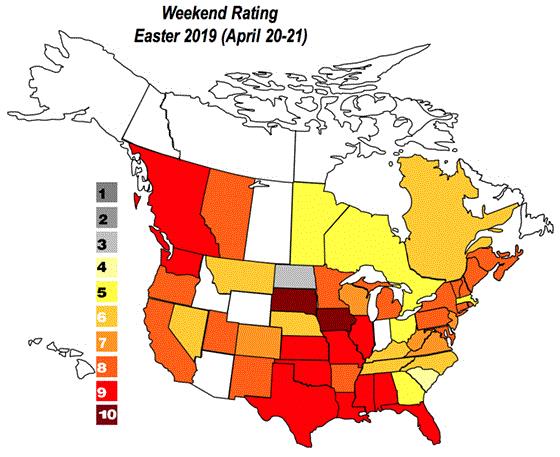Easter 2019: Average (literally)
“Average” is how I would rate Easter Weekend 2019, which came in at 7.4 for the U.S. and 6.8 for Canada. That’s because Easter 2019 was just 0.4 above the six-year average for the U.S. (7.0) and 0.3 above the six-year average for Canada (6.5).
Here are the scores from Easters past from which I did that calculation:
|
2018
|
2017
|
2016
|
2015
|
2014
|
2013
|
2012
|
2011
|
|
5.3/6.4
|
8.2/6.9
|
6.6/7.1
|
7.1/5.3
|
7.4/6.2
|
n/a
|
7.1/6.9
|
n/a
|
And here’s what average looks like on the map:

That’s based on 104 scores from 44 states and 6 provinces.
Regionally, too, your scores were dead down the middle. The Northwest scored a very nice above-average 8.3, but every other region was in the 7s:
South 7.3
West 7.3
Midwest 7.5
New England 7.4
East 7.6
Mountain 7.1
Plains 7.6
Northwest 8.3
I don’t think I’ve ever seen such a consistently “normal” weekend!
Where it was hot and not so hot
Of course, some of you (you know who you are) are above average: thirteen of you scored your weekend a 10. However, eleven of you scored it 2, 3, 4 or 4. At least nobody reported it as a total dud 1.
The strongest states and provinces (those with multiple scores): Kansas was 9.3, Oklahoma was 9.3 and Missouri was 9.0. British Columbia led Canada with 8.8.
At the low end were Tennessee (6.2), Kentucky (6.1), Ohio (4.7) and, in Canada, Ontario at 5.2. But even in these tough locales, the scores ranged from low to relatively high:
Tennessee: 4 to 8
Kentucky: 4 to 8
Ohio: 4 to 7
Ontario: 2 to 9
A striking difference, eh? Lots of possible reasons why that is, including:
- Localized weather (bad weather across part of the state/province, and sunny weather across another)
- Differences in mindset and preparedness between businesses (some have a knack for drawing more traffic even in bad weather)
- Different business types (a wholesale grower might ship tons of stuff out of state and so isn’t impacted by local weather that slows sales at retail)
You might blame my random scoring method, too, but I don’t think two people will look out the window at similar conditions and one say “It’s a 4” and another say “Nope, it’s an 8.”
Unless it’s me and my friend Bill “I’m not a pessimist, I’m a realist” Swanekamp. And even Bill gave New Jersey a decent 6 while the other two respondents from the state both rated the state’s weekend an 8.

Your scores and comments, from high to low
Iowa (10): “Perfect weather, [temperatures in the] 70s and 80s. Customers were clamoring to meet the Easter Bunny, ride our train and bounce in our bounce house. Parking lot was one in/one out for the morning on Saturday. Awesome weekend. Game on.”—Kate Terrell, Wallace's Garden Center
Washington (10): “Weather makes all the difference in this industry, and great weather made for a great weekend!”—David Vos, Vander Giessen Nursery
Alabama (8): “Good, not great. No record-breaking days all spring, but better than average every day. Still, would’ve expected more from an Easter Saturday.”—JD Boone, Dothan Nurseries
Atlantic Provinces, New England, Eastern New York (8): “Nice, solid start to the season. Pansies selling out, and other product is beginning to move as well. If it continues this way, we’ll be very happy indeed!”—David Keeler, Jolly Farmer
California (8): “Thursday and Friday were gangbusters! Wind came in on Saturday, which hurt business. Sunday we were open 10 to 2, and in those four hours we did as much as on Saturday!”—John Vitale, North Star Nursery, Garden & Home
Wisconsin (8): “The weekend would have been a 10 if we didn’t lose Sunday to Easter. I would like to petition that Easter is always the second or third weekend in March.”—Chris Williams, K&W Greenery
British Columbia (7): “Lackluster. Not a terrible weekend, but soft.”—Renata Triveri, Grow & Gather
Ontario (6): “Rain, rain, go away, come again in, like, three months! People came out and sales were up, but the rain put a damper on things, pun intended.”—Will Heemen, Heemen’s
Kentucky (4): “Nasty, cold Saturday, closed Sunday. The only thing that saved the week was strong lily sales.”—Jesse Shelton, Shelton’s Greenhouses
Massachusetts (2): “Weather not great; a cold, late spring; sales extremely slow; a good amount of product going in the dumpster today.”—Dick Chase, Arrowhead Family Farm
Abe Van Wingerden of Metrolina Greenhouses dependably sends me weekly scores and notes for the 13 East, Southeast and Midwest states his business serves. I know he keeps excellent records, and so his scores are based more on year-on-year comparisons than gut instinct. But Spring 2019 has been particularly hectic for Abe, so he only this week got around to sending me scores for every spring weekend thus far. Here’s his Easter commentary:
“Our best weather day this weekend was Sunday, but Easter Sunday is a traditional slow traffic day in the South, no matter when Easter falls and how the weather is.
NC/SC/GA/TN (4): “Cold/rainy on Friday and Saturday, and even with great weather Sunday it was still on the cool side.”
WV/KY/VA (6): “Some good sales in some areas, but overall a softer-than-hoped weekend, even with a good Sunday.”
PA/MD/NJ/NY (8): “Some clouds, but when it’s warmer in Philadelphia in April than it is in Atlanta, you know it’s going to be good for sales up north.”
KS/MO (10): “Could not ask for better weather and traffic. Right up there with best-weekend-of-the-year numbers. Consumers were out in full force—a great sales weekend.”

Do we expect too much from Easter?
Abe and a few others made the point that Easter Sunday isn’t necessarily a good sales day. Folks are too busy doing church and dinner and other family things. For instance, Jerome Vite of Vite Greenhouses in Michigan, who scored it an 8, wrote:
"Pretty good weekend, but from past history we’ve had a bit of a slowdown on Saturdays before Easter Sunday in April. With Easter being so late this year sales held strong, but I think holiday prep for Sunday held some people back.”
And you saw the comment in the previous section from Chris Williams about wanting to petition to have Easter in March, when sales are not as strong anyway.
Now that is speaking strictly from a retail store traffic perspective, of course. Growers do all their shipping in the week or two leading up to Easter. They use Sunday to regroup and prepare for Monday when their customers holler about restocking.
What’s your view on Easter weekend as a Spring weekend? Important? Or less important than any other April weekend … provided said weekend is warm and sunny, of course! Send your thoughts to beytes@growertalks.com

NGMA hopes to block proposed greenhouse energy regulations
Wouldn’t it be great if greenhouses had to meet the same sorts of energy conservation codes as all other buildings?
Of course not! That’s nuts!
Yet that’s what one possible change to the IECC—the International Energy Conservation Code—could mean to someone building a new greenhouse.
Thankfully, the National Greenhouse Manufacturers Association (NGMA) is on the job, watching for possible building code changes that could negatively impact greenhouses and fighting on your behalf. NGMA proposes appropriate changes and clarifications, opposes proposals that have a negative impact on the industry, and provides resources for education and interpretation of the codes.
According to Matt Stuppy, President of greenhouse manufacturer Stuppy, Inc. and a member of NGMA’s Codes and Standards Committee, there are two significant proposed changes to the IECC coming in 2019 that greenhouse owners and operators should know about. One could be good, the other definitely would not be.
“These proposals take opposite view points of greenhouses,” Matt explains. “The first would potentially eliminate energy code regulation of greenhouses, and the second proposal adds more language, removes some greenhouse exemptions, and increases the risk for long-term impacts on the horticulture industry.”
The first proposal, known as CE6-19, is intended to restore the energy code to its original intent of regulating spaces for human comfort and occupancy. This change recognizes that some buildings use energy for industrial, production, and specialized processes. Since the majority of greenhouse energy use is for growing and maintaining plants, NGMA believes that greenhouses should be exempted from all, or the majority, of the energy code.
“In the past, NGMA has worked to exempt the thermal envelope (glass, polycarbonate, acrylic, polyethylene coverings) of the greenhouse from the energy code,” says Matt.
NGMA will be supporting CE6-19 since it clarifies and minimizes the role of the energy code as it relates to greenhouses.
The second proposal, known as CE56-19 and proposed by the NW Energy Codes Group, will be opposed by NGMA. This proposal would put significant and impractical regulation on greenhouse operators.
Some of the key problems with the proposal:
- Greenhouses will be grouped with sunrooms and skylights in the energy code
- The greenhouse exemption for thermal envelopes in the energy code would be removed
- It would require installation of internal energy curtains on all greenhouses without regard to the purpose and/or growing season for the structure
- It would require opaque, insulated walls and ends for greenhouses
- It would create a negative perception that greenhouses are not energy efficient and should be further regulated
NGMA will oppose CE56-19, because it overreaches on regulating greenhouse energy, and it tries to lump all greenhouses together regardless of their use or purpose.
Detailed information on these codes can be found on the International Code Council’s website.
Like it or not, the energy conservation code will continue to gain adoption throughout the United States, and greenhouse owners will continue to see the effects and requirements of the energy code impact their operations.
Says Matt, “Now is the time to protect the industry and make sure greenhouses are properly understood and the codes are correctly applied to different greenhouse applications.”
To learn more about making your greenhouse energy efficient or to find out more about the NGMA please visit www.ngma.com. You can download the NGMA helpful hints on energy conservation at https://ngma.com/wp-content/uploads/2018/03/Energy-Conservation.pdf.
GrowerTalks has long been a proud member of NGMA, so we can support these important efforts on behalf of greenhouse owners.

Burpee gets new President/CEO
For the first time since George Ball purchased the company and took the helm in 1991, W. Atlee Burpee company has a new Chief Executive: Mr. James “Jamie” Mattikow. He joined Burpee effective April 1.

The 55-year-old brings more than 25 years of marketing and brand management experience at companies such as Kraft, Mars, Cosi Inc., Seagram Beverage Company and Hasbro. Most recently, he served as Chief Commercial Officer at Ferrara Candy Company, where he led the Chicago company’s everyday and seasonal category and marketing team,s and was responsible for Ferrara’s R&D group.
George Ball will remain as Chairman of Burpee.
Said George in the press release, “Jamie Mattikow has been an achiever throughout his career and brings to Burpee a wide range of experience and skills that will enable the company to realize significant expansion in allied fields, while retaining and advancing our leadership in all aspects of home gardening.”
Mother’s Day might be up!
Whether or not they’ll spend it on our stuff is yet to be seen, but Mother’s Day spending is expected to hit a record $25 billion this year, up from $23.1 billion in 2018. Some $2.6 billion of that should be on flowers. That’s according to the National Retail Federation’s annual survey on the topic.
“Mother’s Day spending has been growing consistently over the past several years, and this year’s spending is expected to be the highest in the 16-year history of our survey,” NRF President and CEO Matthew Shay said. “Consumers are excited to celebrate all the moms in their lives, and retailers are ready to inspire consumers with unique gift options.”
 Now THAT looks like a memorable Mother's Day for the whole family!
Now THAT looks like a memorable Mother's Day for the whole family!
While the number of people celebrating Mother’s Day is in line with last year’s 86 percent, those celebrating are expected to spend more, at an average $196 compared with $180 in 2018. Consumers ages 35-44 are likely to spend the most, at an average $248, up from $224. Men are likely to spend more than women—$237 compared with $158.
Newer models of gift-giving, including special outings and gift cards, are growing, in addition to more traditional gifts including flowers, greeting cards, and jewelry. Increased spending on jewelry represents 31 percent of the expected increase over last year.
When asked what they would buy and how much they’d spent, respondents cited finding something unique (44 percent) as the most important factor when picking out a Mother’s Day gift, followed by one that creates a special memory (39 percent). More than 8 in 10 (81 percent) indicate they will look to retailers for gifting inspiration.
That says to me we should promote unique plant products presented in an inspirational way and sold in memorable surroundings.
By the way, that flower expenditure figure of $2.6 billion is higher than any category other than jewelry ($5.2 billion), special outings ($4.6 billion) and gift cards/gift certificates (tied at $2.6 billion).
“Mother’s Day is about celebrating a very special person or persons in your life,” Prosper Vice President of Strategy Phil Rist said. “Consumers today want to make sure they’re gifting mom something that will make her feel loved. And they’ll use all the inspiration and guidance they can get in finding that perfect gift.”




See you next time,

Chris Beytes
Editor
GrowerTalks and Green Profit
This e-mail received by 23,608 loyal readers!
Thanks to my loyal sponsors, who help me reach the 23,608 readers of Acres Online in 66 countries. Want to be one of them (a sponsor, that is)? Give Paul Black a shout and he'll hook you up.